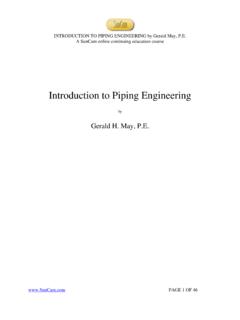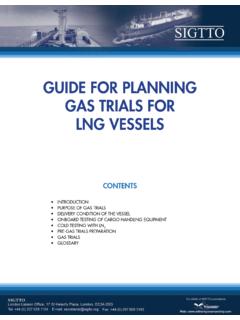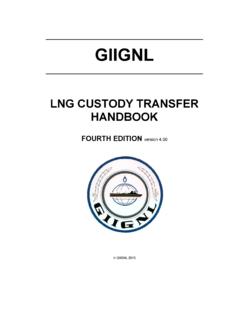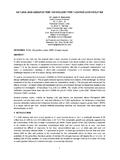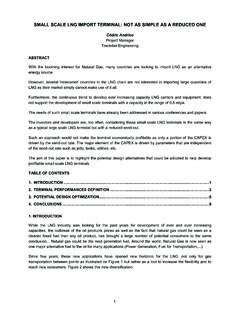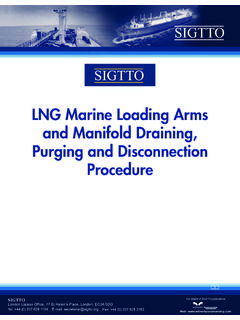Transcription of LNG STORAGE TANK CONSTRUCTION - Piping
1 _____The natural gas that is processed into LNG is explored for, and produced, in an identical way to natural gas. It is typically discovered in conjunction with oil exploration operations. Once extracted, the natural gas can be transported to a liquefaction plant where it is super cooled to 162 C using refrigerants. LNG tanks are usually _____ 1 General Manager, Structural Systems (Western) Pty Ltd, Australia 2 Group Principal Engineer, Structural Systems Ltd, Australia 3 Project Manager, BBR Pretensados y T cnicas Especiales, , Spain 4 Managing Director, BBR VT International, Switzerland DESIGN AND CONSTRUCTION ASPECTS OF POST-TENSIONED LNG STORAGE tanks IN EUROPE AND AUSTRALASIA Hudson Lun 1 Frank Filippone 2 Diana Cobos Roger 3 Marcel Poser 4 INTRODUCTION The growing world-wide use of liquefied natural gas (LNG)
2 Has seen the development of significant LNG STORAGE tank facilities for LNG exporters and importers. These massive STORAGE tanks are essential for receiving and safe STORAGE of the liquid gas. The STORAGE temperature of LNG is 162 C and is described as cryogenic conditions. The liquid occupies 600 times less space than natural gas in its gaseous state, making it practical to ship by ocean tanker. And it's stable and safe, because even though compressed in volume, the liquid remains at normal atmospheric pressure.
3 On land, LNG is stored in specially engineered and constructed double-walled STORAGE tanks . At these temperatures, the requirements for the containment structures are very stringent and post-tensioned concrete tanks are ideally suited to the task. The large concrete tank structures are extremely robust with significant amounts of prestressing required all being designed and installed under tightly controlled quality conditions with hardware requiring special certifications.
4 The design and CONSTRUCTION techniques have been specially formulated for LNG tank CONSTRUCTION and this paper will outline typical details as employed on various projects around the world. BACKGROUND LNG or Liquefied Natural Gas is natural gas that has been super cooled to a temperature around 162 C, whereby it condenses into a liquid form. The process is not a new one, having been proven in 1917 and first used in the United States over 60 years ago. The main benefit of the cooling is that the LNG is reduced to around 1/600th of its volume as gas.
5 It also weighs only about 45% as much as an equivalent amount of water. This has obvious benefits in terms of transportation from natural gas rich areas. LNG is a non-toxic, non-corrosive, colourless and odourless fuel. Once the gas has passed through the LNG processing and distribution network, it can be used in conjunction with, or in place of, domestic natural gas as its properties are very similar. sited in close proximity to port facilities ready for transport, and the liquefied natural gas may be stored in liquid form in preparation for shipping.
6 LNG is stored at atmospheric pressure in double-walled tanks : the space between the tanks being filled with insulation. The outer walls of the tank are most commonly constructed from post-tensioned concrete. Over the past few decades, world consumption of LNG has increased more than five-fold and it is predicted that this growth will continue to be very strong. The growing demand from large markets such as China and India combined with the increasing popularity in a large number of other smaller markets has resulted in the development of many new LNG facilities throughout the world.
7 There are significant natural gas reserves globally and exploration companies are rapidly developing facilities for exporting the natural gas with corresponding receiving facilities being planned and built in emerging markets. With a timeframe of some 5-10 years required for planning and CONSTRUCTION , there is currently much activity underway in the LNG supply chain in preparation for current and predicted demands. DESIGN CONFIGURATION Tank dimensions are typically in the order of 80-90m in diameter and 50m in height with a wall thickness in the order of 750mm (refer Figure 1).
8 The post-tensioning tendons are very large and can run in both the vertical and horizontal directions. Vertical tendons can either be single directional tendons from the top of the tank terminating in a recess at the bottom or U tendons starting at the top coming vertically down through the tank curving around through 180 degrees and returning to the top. Figure 1 - Typical LNG tank cross-section Horizontal tendons typically start at a buttress and travel half way around the tank terminating at the opposite buttress.
9 Another tendon commences from the same buttress and travels back through the remaining half of the tank terminating at the original buttress - hence creating a complete hoop from the two tendons. For efficient use of post-tensioning, adjacent tendons are anchored at the alternate buttresses 90 degrees from the above noted buttress. LNG tanks are typically constructed in a design-build fashion and the principal contractor is responsible for determining the specific design requirements for the prestressed concrete.
10 The post-tensioning specialist will examine the required force profile and detail the spacing and tendon size of the post-tensioning. DESIGN REGULATIONS There is no official standard for the design of these tanks and the first guidelines published were based on the pioneering work in cryogenic applications. According to fip SR 88/2, testing is required to be carried out on; Prestressing steel (at room temperature and at cryogenic temperature) Tendon anchorage assembly (at room temperature and cryogenic temperature) Load transfer (at cryogenic temperature) Tests according to these guidelines were completed for the BBR technology in Perth in 2005.
